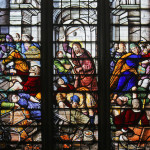We run our website the way we wished the whole internet worked: we provide high quality original content with no ads. We are funded solely by your direct support. Please consider supporting this project.

Rethinking the Resurrection
As much as every other aspect of Jesus life and ministry, I submit that the resurrection must be understood in light of the cross. This event was not anything like the resuscitation of a random corpse. It was the resurrection of the Incarnate Son of God who had fulfilled the human side of the God-human covenant by living a sinless life and who, as an unsurpassable expression of divine love, came to enter into the deepest darkness of evil and assume that evil upon himself. Understood as such, the resurrection can only be viewed as God’s vindication of the self-sacrificial life and death of this God-man through whom God’s eternal character was made known.
For this reason the resurrection must not be interpreted as a display of triumphalist power that contrasts with the humble, cruciform, character of God revealed on the cross as well as throughout Jesus’ life ministry. It was rather a display of power that confirmed that the cross is in fact the revelation of God’s true character and that God’s enemy-loving, non-violent, self-sacrificial way of responding to evil is in fact victorious.
For this reason, the One who sits on the throne in the Book of Revelation and who alone is worthy to open the scroll of God’s plan for history is the victorious lamb who was “slaughtered” (Rev. 4-5; 21:22l 22: 1,4). And for this reason those who conquer are depicted as doing so because they “follow the Lamb wherever he goes” (Rev. 14: 4), bearing witness to his victory and imitating his sacrificial death (Rev. 12:11).
Moreover, throughout Revelation we find the emphatic declaration that the glorified and victorious Jesus is one and the same as the crucified Jesus (see Rev. 5:6, 9, 12; 7:14, 17; 12:11; 13:8; 17:14).
Along the same lines, we can see that the resurrection of Jesus confirmed rather than sat aside the cruciform nature of his life and death in the very fact that for Paul, as much as for John who wrote Revelation, the “glorified” Lord is one and the same as the crucified Lord (2 Cor. 4:4-6; Phil 2:6-11). This is precisely why all who have been raised with Christ and who therefore participate in his resurrected life reflect their participation by taking on a cruciform character that leads them to sacrificially serve others, including their enemies, just as Jesus did.
The same point is made by noting that for Paul, the Spirit that dwells within believers is the Spirit of the crucified Christ that empowers them to live according to “the law of Christ” (Gal 6:2), which is to love others as he loved us “when he gave his life for [us]” (Eph. 5:1-2).
Ernst Käsemann once stated that the cross is “the signature of the one who is risen.” The surest sign that anyone belongs to him is that they participate is Christ’s risen life, which means they participate in the expression of his self-sacrificial love.
Image by Keith Bacongco via Flickr.
Category: General
Tags: Cross, Cruciform Theology, Jesus, Resurrection, Revelation
Topics: Christology
Related Reading

When Jesus Questioned the Father
Though the sinless Son of God had perfect faith, we find him asking God the Father to alter the plan to redeem the world through his sacrifice—if it is “possible” (Matt. 26:42). As the nightmare of experiencing the sin and God-forsakenness of the world was encroaching upon him, Jesus was obviously, and understandably struggling. So,…

Memorial Day
For Memorial Day, we thought we would repost Greg’s thoughts from 2007. In this post, Greg expresses his conflicted feelings over this holiday and gives a brief defense of Christian pacifism. *** Hope you all had a happy Memorial Day. (Isn’t that something of a misnomer — a happy time remembering people killed in war?) Memorial Day…

You’re Not a Pacifist Are You?
Jayel Aheram via Compfight Brian Zahnd wrote a great piece the other day on this topic. He contends that when he is asked this question, it often has the same flavor of the question, “You’re not a pornographer are you?” Why is this question so contentious among believers? Brian has some interesting ideas about it.…

The Cruciform Center Part 1: How Matthew, Mark and Luke Reveal a Cruciform God
In the previous series of posts I’ve argued that a merely “Christocentric” approach to God is too general, as can be shown by the widely different conceptions of God people arrive at, despite their claim to be “Christocentric.” The confession that Jesus reveals what God is like is simply too abstract, for it leaves too…

The Cleansing of the Temple and Non-Violence
Jesus’ cleansing of the Temple is the most commonly cited example of those who allege that he did not absolutize loving enemies or refraining from violence. I submit that this episode implies nothing of the sort. First, it is important that we understand that this episode was not an expression of unpremeditated anger on Jesus’…

Podcast: Does God Strike Jesus Down?
Greg looks at how Matthew uses the Old Testament—specifically, Matthew 26:31. http://traffic.libsyn.com/askgregboyd/Episode_0258.mp3
